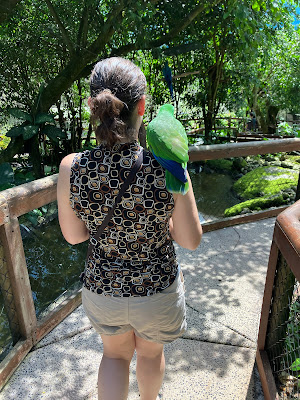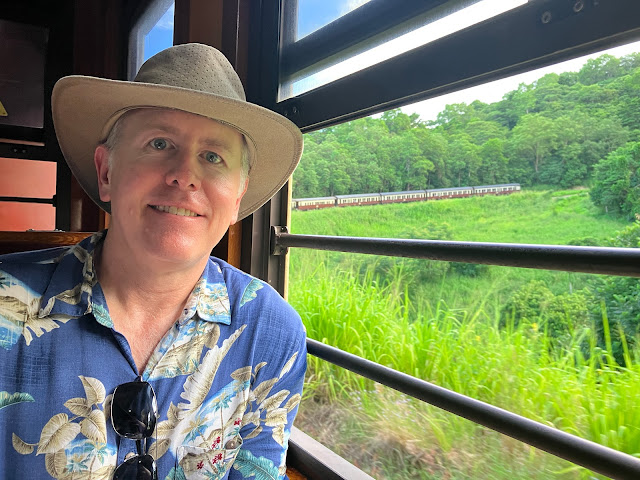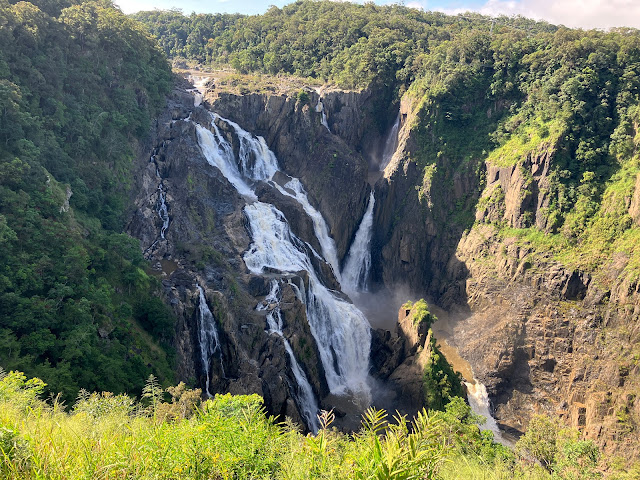For our final week in Australia we flew to the city of Cairns in Northern Queensland. It’s the gateway to both the tropical rainforest and the Great Barrier Reef. There are lots of activities to do in the area. On our first night, we walked around the night arts market and along the shoreside park. The bars along this stretch were packed with people since it was a Friday night. I remember being here and staying out late twenty years ago in my twenties. Now in my late forties the thought of staying out until 2am and then going sightseeing early the next day sounds exhausting. We headed back to the hotel at a very reasonable and responsible 9pm.
This morning we took the Kuranda Skyrail, a 4.7 mile long cable car (the world's longest!) that takes you above the canopy of the oldest rainforest on Earth. In the cable car you are suspended over an almost endless sea of green.
You also get amazing views of the Barron River Gorge and the towering 410-foot-high Barron Falls. This is by far the best waterfall we’ve seen in Australia. From the cable car it is just this massive waterfall slicing through the rainforest. It is absolutely spectacular!
The cable car descends right into the town of Kuranda, which is nestled in the heart of the rainforest at an altitude of about 1000 feet. As it descends into town you glide right over the Barron River that feeds the falls.
It’s a popular day trip from Cairns, and there are lots of things to do here. Up first, we hopped on the Barron River Cruise to look for freshwater crocodiles. Unfortunately we had no luck. The guide said there were six “freshies” in the river but this is the warm time of year when they spend most of their time in the water to keep themselves cool. When submerged, they are much harder to spot than when they’re basking in the sun on the banks in winter. So no wild crocs spotted on our trip yet; we’ll have to keep looking! We did get to feed some turtles from the boat, though! They popped their little heads up out of the water expectantly as soon as they heard the boat motor approaching. They are used to getting their snacks on schedule!
After a quick lunch, we walked over to Bird World, an aviary where you can hand-feed hundreds of tropical birds. When we bought our tickets they said they were out of bird food but to put away my necklace and earrings because they go for shiny items when the tourists don’t offer food. I had the surprise of my life when an emerald male Eclectus Parrot hopped directly onto my shoulder unexpectedly.
I tried a few times to get him to perch elsewhere but he was settled in and comfortably hanging on. A staff member even came over to give me a handful of food to try to tempt him away but he was not interested in the food and was stubbornly sticking to my shoulder, so I gave up trying and took him on a walk with me. He was very gentle and just seemed interested in having his picture taken (we took about a million photos, but I won't bore you with all of them!)
Another beautiful Indian Ringneck Parakeet became fascinated with Kevin’s hat. It was lucky that the bird didn’t eat through the fabric, or worse — poop on it!
We saw loads of other colorful native and non-native birds, like this Blue and Gold Macaw (not native to Australia)…
... this Alexandrine Parakeet (also not native)
And this pretty pink Major Mitchell Cockatoo (native to Australia)
But the most exciting one was the cassowary. These bizarre-looking flightless birds can get up to almost six feet tall and have been in existence since prehistoric times. They have a very important role in the rainforest ecosystem— they the only creatures that are able to eat and digest the fruits that grow here. They excrete the seeds and new trees and plants can grow. Without the cassowary, there would be no rainforest here — they are an essential part of a healthy forest. These birds are endangered due to habitat loss and getting hit by cars. They are considered a keystone species because Australia's tropical rainforest truly would not survive without them.
We returned to Cairns via the Kuranda Scenic Railway. Chugging along through 15 tunnels and a couple of u-turn type curves, the train has been a connection between Cairns and Kuranda for over 130 years. It was constructed when gold was found in the North Queensland mountains here. We enjoyed the scenery of the mountainous rainforest as we descended back down to sea level.
From the railway, we were able to get one last look at the mighty Barron Falls from the other side of the gorge. Such an awe-inspiring sight!
At dinner tonight, Kevin finally got to try a local specialty— kangaroo steak. It tastes a bit like steak but has a gamey kind of texture that makes it not as appealing as beef steaks. We met a butcher from Sydney on one of our tours who told us that it’s not very commonly eaten outside of touristy restaurants. It’s expensive because the kangaroos have to be farmed, not wild, so that they can be sure the meat is disease and parasite-free. Only the rear haunch and the rump are decent eating and the Australian government regulates the quality. Even still, it’s worth trying once. We preferred the Thai chili crocodile appetizer. It did indeed “taste like chicken “! I wish I'd taken a good photo of the meal, but both dishes just looked like regular steak and chicken. So instead, please enjoy this totally real and life-like photo of us on the Skyrail. I like how it almost seems like the rainforest was right there in the car with us:















No comments:
Post a Comment